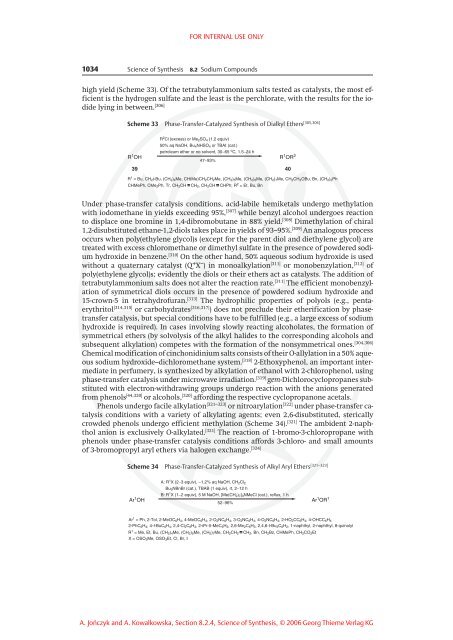Sodium–Oxygen Compounds
Sodium–Oxygen Compounds
Sodium–Oxygen Compounds
You also want an ePaper? Increase the reach of your titles
YUMPU automatically turns print PDFs into web optimized ePapers that Google loves.
high yield (Scheme 33). Of the tetrabutylammonium salts tested as catalysts, the most efficient<br />
is the hydrogen sulfate and the least is the perchlorate, with the results for the iodide<br />
lying in between. [306]<br />
Scheme 33 Phase-Transfer-Catalyzed Synthesis of Dialkyl Ethers [305,306]<br />
R 1 OH<br />
39<br />
R2Cl (excess) or Me2SO4 (1.2 equiv)<br />
50% aq NaOH, Bu4NHSO4 or TBAI (cat.)<br />
petroleum ether or no solvent, 30−65 oC, 1.5−24 h<br />
47−93%<br />
R 1 OR 2<br />
R 1 = Bu, CH 2t-Bu, (CH 2) 4Me, CH(Me)CH 2CH 2Me, (CH 2) 5Me, (CH 2) 6Me, (CH 2) 7Me, CH 2CH 2OBu, Bn, (CH 2) 2Ph<br />
CHMePh, CMe2Ph, Tr, CH2CH CH2, CH2CH CHPh; R 2 = Et, Bu, Bn<br />
Under phase-transfer catalysis conditions, acid-labile hemiketals undergo methylation<br />
with iodomethane in yields exceeding 95%, [307] while benzyl alcohol undergoes reaction<br />
to displace one bromine in 1,4-dibromobutane in 88% yield. [308] Dimethylation of chiral<br />
1,2-disubstituted ethane-1,2-diols takes place in yields of 93–95%. [309] An analogous process<br />
occurs when poly(ethylene glycol)s (except for the parent diol and diethylene glycol) are<br />
treated with excess chloromethane or dimethyl sulfate in the presence of powdered sodium<br />
hydroxide in benzene. [310] On the other hand, 50% aqueous sodium hydroxide is used<br />
without a quaternary catalyst (Q + X – ) in monoalkylation [311] or monobenzylation, [312] of<br />
poly(ethylene glycol)s; evidently the diols or their ethers act as catalysts. The addition of<br />
tetrabutylammonium salts does not alter the reaction rate. [311] The efficient monobenzylation<br />
of symmetrical diols occurs in the presence of powdered sodium hydroxide and<br />
15-crown-5 in tetrahydrofuran. [313] The hydrophilic properties of polyols (e.g., pentaerythritol<br />
[314,315] or carbohydrates [316,317] ) does not preclude their etherification by phasetransfer<br />
catalysis, but special conditions have to be fulfilled (e.g., a large excess of sodium<br />
hydroxide is required). In cases involving slowly reacting alcoholates, the formation of<br />
symmetrical ethers (by solvolysis of the alkyl halides to the corresponding alcohols and<br />
subsequent alkylation) competes with the formation of the nonsymmetrical ones. [304,306]<br />
Chemical modification of cinchonidinium salts consists of their O-allylation in a 50% aqueous<br />
sodium hydroxide–dichloromethane system. [318] 2-Ethoxyphenol, an important intermediate<br />
in perfumery, is synthesized by alkylation of ethanol with 2-chlorophenol, using<br />
phase-transfer catalysis under microwave irradiation. [319] gem-Dichlorocyclopropanes substituted<br />
with electron-withdrawing groups undergo reaction with the anions generated<br />
from phenols [44,320] or alcohols, [320] affording the respective cyclopropanone acetals.<br />
Phenols undergo facile alkylation [321–323] or nitroarylation [322] under phase-transfer catalysis<br />
conditions with a variety of alkylating agents; even 2,6-disubstituted, sterically<br />
crowded phenols undergo efficient methylation (Scheme 34). [321] The ambident 2-naphthol<br />
anion is exclusively O-alkylated. [321] The reaction of 1-bromo-3-chloropropane with<br />
phenols under phase-transfer catalysis conditions affords 3-chloro- and small amounts<br />
of 3-bromopropyl aryl ethers via halogen exchange. [324]<br />
Scheme 34 Phase-Transfer-Catalyzed Synthesis of Alkyl Aryl Ethers [321–323]<br />
Ar 1 OH<br />
FOR INTERNAL USE ONLY<br />
1034 Science of Synthesis 8.2 Sodium <strong>Compounds</strong><br />
A: R1X (2−3 equiv), ~1.2% aq NaOH, CH2Cl2<br />
Bu3NBnBr (cat.), TBAB (1 equiv), rt, 2−12 h<br />
B: R1X (1−2 equiv), 5 M NaOH, [Me(CH2)7]3NMeCl (cat.), reflux, 1 h<br />
52−96%<br />
Ar1 = Ph, 2-Tol, 2-MeOC6H4, 4-MeOC6H4, 2-O2NC6H4, 3-O2NC6H4, 4-O2NC6H4, 2-HO2CC6H4, 4-OHCC6H4 2-PhC6H4, 4-t-BuC6H4, 2,4-Cl2C6H3, 2-iPr-5-MeC6H3, 2,6-Me2C6H3, 2,4,6-t-Bu3C6H2, 1-naphthyl, 2-naphthyl, 8-quinolyl<br />
R H2 CH2, Bn, CH2Bz, CHMePh, CH2CO2Et X = OSO3Me, OSO3Et, Cl, Br, I<br />
1 = Me, Et, Bu, (CH2) 4Me, (CH2) 5Me, (CH2) 7Me, CH2C 40<br />
Ar 1 OR 1<br />
A. Jończyk and A. Kowalkowska, Section 8.2.4, Science of Synthesis, 2006 Georg Thieme Verlag KG

















